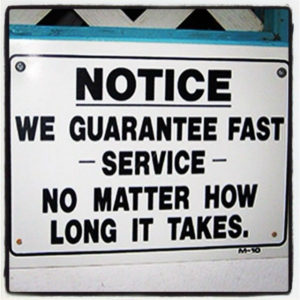“Just send everything out whenever it’s ready.” You hear this phrase uttered a lot waiting tables. It’s maddening. Well-intentioned guests say it as though they’re doing everyone a favor but, in reality, it’s an inconvenience to have everything served piecemeal. It’s not their fault—most people have no clue how restaurant kitchens operate. Spoiler: there isn’t a ready fairy that sprinkles ready dust on your food as soon as it’s done. Professional kitchens require disciplined organization to deliver a food experience both flavorful and punctual. Most of the time, this does not allow for the luxury of sporadically sending food out to random tables throughout the night. In the chaos of service, readiness is constantly in flux.
When your food comes out is determined by a confluence of factors: where other tables are in their meal, how busy the restaurant is and what menu items you’ve selected. But the path toward readiness doesn’t always begin the moment you place your order. In fact, most times it starts much later. The kitchen might’ve been just about to begin grilling your steak when a striped bass from someone else’s table is sent back undercooked. Now your steak will have to wait a few extra minutes while the grill cook “re-fires” the fish. Proverbial shit happens, but shit splatters all over the proverbial walls in restaurants. Nothing that relates to restaurant timing—including the availability of your table at the time of your reservation—occurs in a vacuum.
 Ever wait gratuitously long for a main course when you didn’t order an appetizer? Your waiter implored you to start with something first, but you didn’t listen. You were certain he was just being solicitous. The truth is he warned you because long waits don’t only occur when dishes take longer to cook. Your food is often delayed because a busy kitchen has to finish the main course orders for the other tables who ordered before you. Even though you wish it would, time doesn’t stop for the kitchen to start cooking just for your table. If they start cooking your food right away, it will be at the expense of everyone sitting in the dining room who has already had appetizers and are expecting their next course. Preparation will begin on your dishes only when the kitchen has pushed out the rest of the tickets that came in ahead of yours. We’ve discussed this concept—what restaurants call “order fire”—in an earlier article.
Ever wait gratuitously long for a main course when you didn’t order an appetizer? Your waiter implored you to start with something first, but you didn’t listen. You were certain he was just being solicitous. The truth is he warned you because long waits don’t only occur when dishes take longer to cook. Your food is often delayed because a busy kitchen has to finish the main course orders for the other tables who ordered before you. Even though you wish it would, time doesn’t stop for the kitchen to start cooking just for your table. If they start cooking your food right away, it will be at the expense of everyone sitting in the dining room who has already had appetizers and are expecting their next course. Preparation will begin on your dishes only when the kitchen has pushed out the rest of the tickets that came in ahead of yours. We’ve discussed this concept—what restaurants call “order fire”—in an earlier article.
To help the kitchen stay organized, most restaurants require the server to “course-out” dishes—to design a road map for your meal. When these schematics are poorly drawn, the guest experience usually suffers. Chefs will terrorize servers who make a habit of sending order fire tickets to the kitchen; firing food is cyclical and single-course “as ready” orders disrupt the flow. If you don’t want your food coursed, it will go in as an order fire. The server might go back and ask the kitchen to send the food ASAP but the Chef will tell him—usually profanely—that the food will come out whenever the fuck the kitchen says. Servers have little control over timing; it’s ultimately the Chef’s prerogative. If a salad takes five minutes, a pasta seven and a lamb chop fifteen—the kitchen will begin cooking the lamb chops first, fire the pasta eight minutes later and then begin making the salad two minutes after that. At the fifteen minute mark, all three dishes are sent out simultaneously and the order ticket is spiked. Fifteen minutes doesn’t sound like a very long time but it feels like an eternity when you expected at least the appetizers to be ready right away.
So why are chefs so averse to sending food out whenever it’s ready? There are a few important factors that help to understand why. Chefs don’t like loose ends. Staying organized is critical when the kitchen gets busy and sending out the salad, the pasta and the lamb at different times can lead to confusion. Did Table Fifteen’s salad go out yet? Do you still have a lamb working? Streamlining how food is fired minimizes mistakes. More importantly, in the heat of the dinner rush, different orders need to bundled together for efficiency. If the Chef has a total of three lamb chops ordered all day (“kitchenspeak” for in total), he may hold your table’s order an extra five minutes so he can instruct the grill cook to prepare all three lamb chops together. To be put more plainly, your food is ready when we say it’s ready.
 Sending food at random creates havoc in the dining room, too. Servers need time to clear dirty plates, to reset and change silverware. Food runners will arrive to the table confused about where they’re supposed to put the plates down. Restaurants function like well-oiled machines and anything that violates protocol grinds the gears. It also leads to sloppy service. Do you really want to cut your lamb chops with an appetizer knife or eat your pasta on a plate with leftover salad dressing on it? Once you refuse to play by our rules, you have to sleep in the bed you’ve made for yourself.
Sending food at random creates havoc in the dining room, too. Servers need time to clear dirty plates, to reset and change silverware. Food runners will arrive to the table confused about where they’re supposed to put the plates down. Restaurants function like well-oiled machines and anything that violates protocol grinds the gears. It also leads to sloppy service. Do you really want to cut your lamb chops with an appetizer knife or eat your pasta on a plate with leftover salad dressing on it? Once you refuse to play by our rules, you have to sleep in the bed you’ve made for yourself.
As with many things that relate to restaurant service, it’s always best to defer to the expertise of the staff. A wiser approach would be to tell your server to send the order however he thinks is best. Remember, smooth service is in everyone’s best interest. Don’t sabotage yourself by thinking your way is better.



